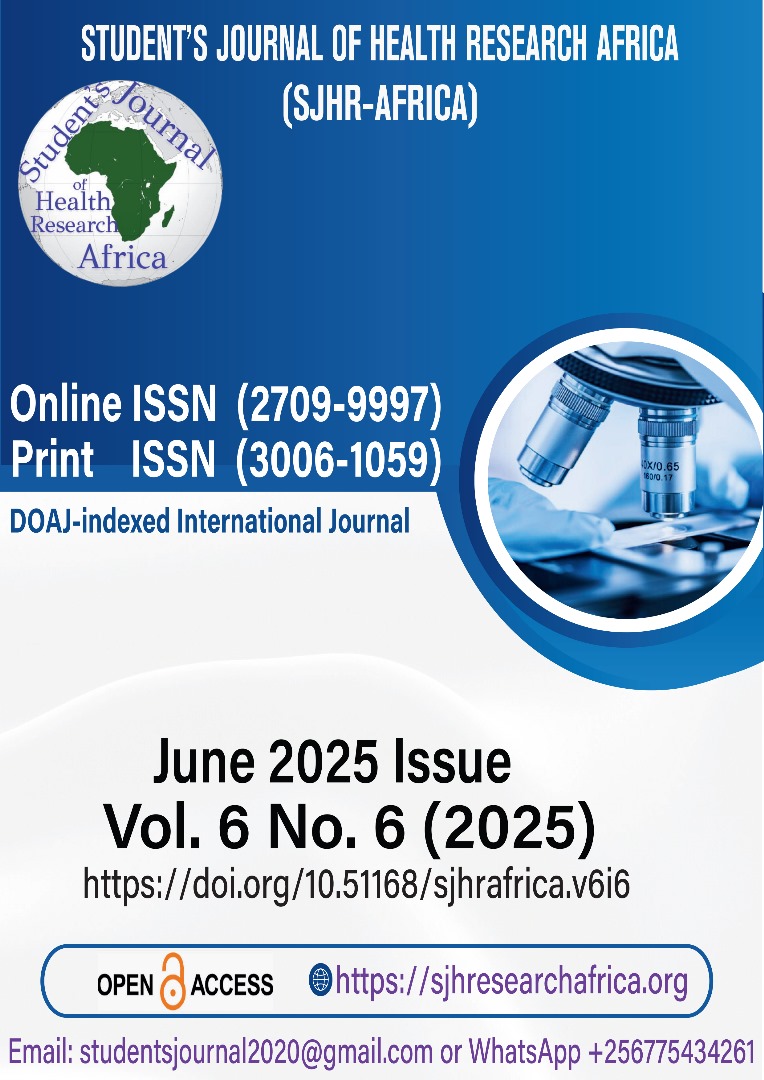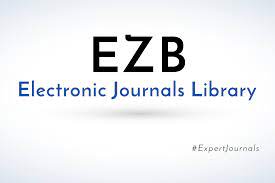Incidental discovery of xanthogranulomatous cholecystitis as a mimicker of gall bladder adenocarcinoma: A retrospective cohort study.
DOI:
https://doi.org/10.51168/sjhrafrica.v6i6.1807Keywords:
Xanthogranulomatous Cholecystitis, Cholelithiasis, Gall bladder, CholecystectomyAbstract
Background
Xanthogranulomatous cholecystitis (XGC) is an inflammatory condition characterised by the intramural accumulation of lipid-laden macrophages in the bladder wall. Sometimes, XGC results in adhesions of the gall bladder to adjacent organs, causing the formation of fistulous tracts and bladder perforation. Intense adhesions lead to mass formation, giving a false impression of malignancy on radiological investigations and intraoperatively. Such cases are resolved only after final histopathological diagnosis, making it the gold standard.
Aims and Objectives: The study was conducted to outline and review the presentations and investigations in cases of XGC in order to structure an approach to managing diagnostic dilemmas in treating such patients.
Materials and methods
An observational, retrospective study was conducted in the Pathology department at IGIMS, Patna. A total of 1260 cholecystectomy samples with a preoperative diagnosis of gall bladder cancer (GBC), received from January 2019 to December 2024, were included in our study. Cases were selected as per the inclusion and exclusion criteria.
Results
Statistical analysis showed that out of 1260 specimens, preoperatively diagnosed as GBC, 59 were diagnosed as XGC on histopathological examination (Group X). Group Y had a greater incidence of anorexia and weight loss. Radiological findings on retrospect in group X displayed specific features suggestive of XGC, namely diffuse gall bladder wall thickening, hypoattenuated submucosal nodules, intrahepatic duct dilatation, continuous mucosal line enhancement, and loss of interface between the gall bladder and liver.
Conclusion
It is difficult to diagnose XGC from GBC preoperatively in all cases. Histopathological examination serves as the cornerstone in such diagnostic dilemmas.
Recommendations
A multidisciplinary approach and increased awareness are key to accurate diagnosis and appropriate management.
References
Goodman ZD, Ishak KG. Xanthogranulomatous cholecystitis. Am J Surg Pathol. 1981;5(7):653-9. https://doi.org/10.1097/00000478-198110000-00007 PMid:7337158
Yucel O, Uzun MA, Tilki M, Alkan S, Kilicoglu ZG, Goret CC. Xanthogranulomatous cholecystitis: analysis of 108 patients. Indian J Surg 2017;79:510 4. https://doi.org/10.1007/s12262-016-1511-0 PMid:29217901 PMCid:PMC5711709
Kwon AH, Matsui Y, Uemura Y. Surgical procedures and histopathologic findings for patients with xanthogranulomatous cholecystitis. J Am Coll Surg 2004;199:204 10. https://doi.org/10.1016/j.jamcollsurg.2004.03.018 PMid:15275874
Guzmán-Valdivia G. Xanthogranulomatous cholecystitis: 15 years' experience. World J Surg 2004;28:254 7. https://doi.org/10.1007/s00268-003-7161-y PMid:14961199
AhnYJ, KimTH, MoonSW, ChoiSN, KimHJ, JungWT, et al. A case of perforated xanthogranulomatous cholecystitis presenting as biloma. Korean J Gastroenterol 2011;58:153 6. https://doi.org/10.4166/kjg.2011.58.3.153 PMid:21960104
Cui Y, Zhang H, Zhao E, Cui N, Li Z. Differential diagnosis and treatment options for xanthogranulomatous cholecystitis. Med Princ Pract 2013;22:18-23. https://doi.org/10.1159/000339659 PMid:22814128 PMCid:PMC5586703
Deng YL, Cheng NS, Zhang SJ, Ma WJ, Shrestha A, Li FY, et al. Xanthogranulomatous cholecystitis mimicking gallbladder carcinoma: an analysis of 42 cases. World J Gastroenterol 2015;21: 12653-9. https://doi.org/10.3748/wjg.v21.i44.12653n PMid:26640342 PMCid:PMC4658620
Han SH, Chen YL. Diagnosis and treatment of xanthogranulomatous cholecystitis: a report of 39 cases. Cell Biochem Biophys 2012;64:131 5. https://doi.org/10.1007/s12013-012-9381-y PMid:22707297
Yang T, Zhang B, Zhang J, Zhang Y, Jiang X, Wu M. (2007) Surgical treatment of xanthogranulomatous cholecystitis: experience in 33 cases. Hepatobiliary Pancreat Dis Int 6:504-508.
Kwon A-H, Matsui Y, Uemura Y. (2004) Surgical procedures and their topathologic findings for patients with xanthogranulomatous cholecystitis. J Am Coll Surg 199:204 10. https://doi.org/10.1016/j.jamcollsurg.2004.03.018
PMid:15275874
Spinelli A, Schumacher G, Pascher A, Lopez-hanninen E, Al-abadi H, Benckert C et al. (2006) Extended surgical resection for xanthogranulomatous cholecystitis mimicking advanced gallbladder carcinoma: a case report and review of literature. World J Gastroenterol 12:2293 96. https://doi.org/10.3748/wjg.v12.i14.2293 PMid:16610041 PMCid:PMC4087666
Srikanth G, Kumar A, Khare R, Siddappa L, Gupta A, Sikora SS, et al. Should laparoscopic cholecystectomy be performed in patients with a thick-walled gallbladder? J Hepatobiliary Pancreat Surg. 2004;11(1):40-4. https://doi.org/10.1007/s00534-003-0866-3 PMid:15754045
Guzman-Valdivia G. Xanthogranulomatous cholecystitis in laparoscopic surgery. J Gastrointest Surg. 2005 Apr;9(4):494-7. https://doi.org/10.1016/j.gassur.2004.09.036 PMid:15797229
Guzman VG. "Xanthogranulomatous cholecystitis: 15 years' experience. World Journal of Surgery. 2004;28(3)254-57. https://doi.org/10.1007/s00268-003-7161-y PMid:14961199
Spinelli A, Schumacher G, Pascher et al. Extended surgical resection for xanthogranulomatous cholecystitis mimicking advanced gallbladder carcinoma: a case report and review of the literature. World Journal of Gastroenterology. 2006;12(14)2293-96. https://doi.org/10.3748/wjg.v12.i14.2293 PMid:16610041 PMCid:PMC4087666
Srinivas GN, Sinha S, Ryley N, Houghton W. Perfidious gallbladders-a diagnostic dilemma with xanthogranulomatous cholecystitis. Annals of The Royal College of Surgeons of England. 2007;89:168-72. https://doi.org/10.1308/003588407X155833 PMid:17346415 PMCid:PMC1964568
Zhang LF, Hou CS, Liuetal JY. Strategies for diagnosis of xanthogranulomatous cholecystitis masquerading as gall bladder cancer. Chinese Medical Journal. 2012;125(1)109-13.
Srinivas GN, Sinha S, Ryley N, Houghton PW. Perfidious gall bladder - a diagnostic dilemma with xanthogranulomatous cholecystitis. Ann R Coll Surg Engl. 2007;89(2):168-72. https://doi.org/10.1308/003588407X155833 PMid:17346415 PMCid:PMC1964568
Yang T, Zhang BH, ZhanG, Zhang YJ, Jiang XQ, Wu MC. Surgical treatment of xanthogranulomatous cholecystitis: experience in33cases. Hepatobiliary and Pancreatic Diseases International. 2007;.6(5)504-08.
Sharma D, Babu R, Sood G, Kapoor G, Solanki RS, Thomas S. Xanthogranulomatous cholecystitis masquerading as malignancy with liver metastasis. ANZ Journal of Surgery. 2009;79(12):946-47. https://doi.org/10.1111/j.1445-2197.2009.05150.x PMid:20003001
Zhang LF, Hou CS, Liuetal JY. Strategies for diagnosis of xanthogranulomatous cholecystitis masquerading as gallbladder cancer. Chinese Medical Journal. 2012;125(1):109-13. https://doi.org/10.1097/CM9.0000000000000022 PMCid:PMC6629301
Kim PM, Lee SH, Gongetal GY. Xanthogranulomatous cholecystitis: radiologic findings with histologic correlation that focuses on intramural nodules. American Journal of Roentgenology. 1999;172(4):949-53. https://doi.org/10.2214/ajr.172.4.10587127
Uchiyama K, Ozawa S, Ueno et al. M. Xanthogranulomatous cholecystitis: the use of preoperative CT findings to differentiate it from gall bladder carcinoma. Journal of Hepato-Biliary Pancreatic Surgery. 2009;16(3):333-38.
https://doi.org/10.1007/s00534-009-0067-9 PMid:19280109
Chang S, , Wang JH,, Kanematsu M, Bae KT, Federle MP. Xanthogranulomatous cholecystitis: diagnostic performance of CT to differentiate from gallbladder cancer. European Journal of Radiology. 2012;74(3):79-83. https://doi.org/10.1016/j.ejrad.2009.04.017 PMid:19446416
Goshima S, Chang S, Wang JH, Kanematsu M, Bae KT, Federle MP. Xanthogranulomatous cholecystitis: diagnostic performance of CT to differentiate from gallbladder cancer. Eur J Radiol. 2010;74:79 83. https://doi.org/10.1016/j.ejrad.2009.04.017 PMid:19446416
Chang BJ, Kim SH, Park HY, Lim SW, Kim J, Lee KH et al. Distinguishing xanthogranulomatous cholecystitis from the wall thickening type of early-stage gallbladder cancer. Gut Liver. 2010; 4:518-523. https://doi.org/10.5009/gnl.2010.4.4.518 PMid:21253302 PMCid:PMC3021609
Krishnani N, Dhingra S, Kapoor S, Pandey R. Cytopathologic diagnosis of xanthogranulomatous cholecystitis and coexistent lesions. A prospective study of 31 cases. Acta Cytol. 2007;51:37 41. https://doi.org/10.1159/000325680 PMid:17328493
Hsu C, Hurwitz JL, Schuss A, Katz DS. Radiology pathology conference: xanthogranulomatous cholecystitis. Clin Imaging. 2003;27:421-25. https://doi.org/10.1016/S0899-7071(02)00589-2 PMid:14585573
Downloads
Published
How to Cite
Issue
Section
License
Copyright (c) 2024 Zeenat Sarmadi Imam, Shadan Rabab, Kumari Sunita Bharti, Makarand Hemant Langhe, Bipin Kumar, Manish Mandal, Rakesh Kumar Singh

This work is licensed under a Creative Commons Attribution-NonCommercial-NoDerivatives 4.0 International License.






















